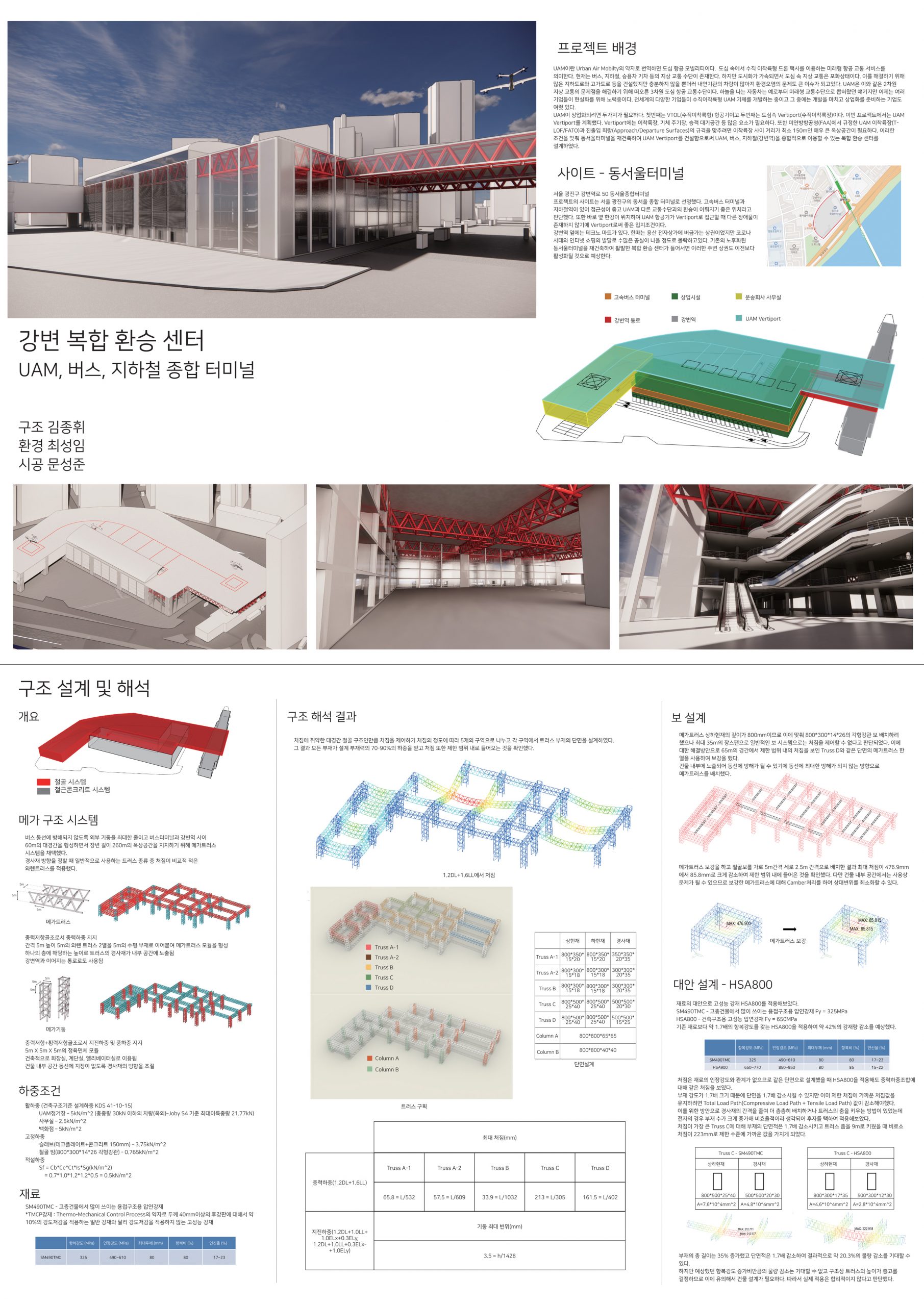김종휘(구조), 최성임(환경), 문성준(CM)
Jonghui Kim (structure), Seongim Choi (environment), Seongjun Moon (CM)
강변 복합 환승 센터
Gangbyeon Complex Transfer Center
UAM이란 Urban Air Mobilty의 약자로, 번역하면 도심 항공 모빌리티이다. 도심 속에서 수직 이착륙형 드론 택시를 이용하는 미래형 항공 교통 서비스를 의미한다. 현재는 버스, 지하철, 승용차, 기차 등의 지상 교통 수단이 존재한다. 하지만 도시화가 가속되면서 도심 속 지상 교통은 포화상태이다. 이를 해결하기 위해 많은 지하도로와 고가도로 등을 건설했지만 충분하지 않을 뿐더러 내연기관의 차량이 많아져 환경오염의 문제도 큰 이슈가 되고있다. UAM은 이와 같은 2차원 지상 교통의 문제점을 해결하기 위해 떠오른 3차원 도심 항공 교통수단이다. 하늘을 나는 자동차는 예로부터 미래형 교통수단으로 뽑혀왔던 얘기지만 이제는 여러 항공 회사에서 현실화를 시키는 중이다. 전세계의 여러 스타트업 기업들이 수직이착륙형 UAM 기체를 개발하는 중이고 그 중에는 개발을 마치고 상업화를 준비하는 기업도 여럿 있다.
UAM이 상업화되려면 두가지가 필요하다. 첫번째는 eVTOL(수직이착륙형) 항공기이고 두번째는 도심속 Vertiport(수직이착륙장)이다. 이번 프로젝트에서는 UAM Vertiport를 계획했다. Vertiport에는 이착륙장, 기체 주기장, 승객 대기공간 등 많은 요소가 필요하다. 또한 미연방항공청(FAA)에서 규정한 UAM 이착륙장(TLOF/FATO)과 진출입 회랑(Approach/Departure Surfaces)의 규격을 맞추려면 이착륙장 사이 거리가 최소 150m인 매우 큰 옥상공간이 필요하다. 이러한 조건을 맞춰 동서울터미널을 재건축하여 UAM Vertiport를 건설함으로써 UAM, 버스, 지하철(강변역)을 종합적으로 이용할 수 있는 복합 환승 센터를 설계하였다.
UAM stands for Urban Air Mobility, which refers to a futuristic air transport service that uses a vertical take-off and landing drone taxi in the city center. Currently, there are on-ground transportation services such as buses, subways, passenger cars, and trains. However, as urbanization accelerates, ground traffic in the city center is saturated. To solve this problem, many underground roads and overpasses have been built, but not only are they not enough, but the environmental pollution is also becoming a big issue as there are more vehicles with internal combustion engines. UAM is a three-dimensional urban air transportation that has emerged to solve such a problem of two-dimensional ground transportation. Flying cars have long been selected as a future mode of transportation, but now many airline companies are on the way to realize it. Several start-up companies around the world are developing vertical take-off and landing UAM aircraft, and several of them have completed development and are preparing for commercialization.
Two things are essential for UAM to be commercialized. The first is an eVTOL aircraft, and the second is an urban Vertiport. In this project, UAM Vertiport was planned. Vertiport requires many elements such as take-off and landing areas, airframe parking lots, and waiting spaces for passengers. In addition, a very large rooftop space with a distance of at least 150m between the takeoff and landing sites is required to meet the standards of the UAM takeoff and landing site (TLOF/FATO) and the approach/department surfaces prescribed by the Federal Aviation Administration (FAA). In line with these conditions, the East Seoul Terminal was rebuilt and the UAM Vertiport was built to design a complex transfer center that could comprehensively use UAM, buses, and subway (Gangbyeon Station).

